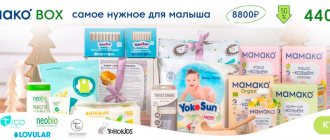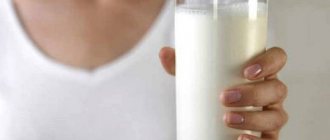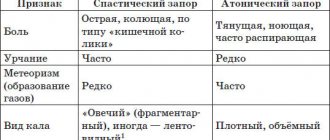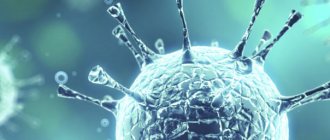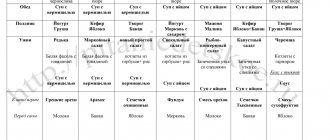23.09.2019 197240 0
Any mother wants her baby to grow up healthy. This is why breastfeeding is so important from the moment your baby is born. Breast milk contains all the beneficial substances, vitamins and microelements necessary for a newborn. During breastfeeding, it is very important that the mother’s diet is rational, varied and balanced.
Why is breastfeeding beneficial?
To begin with, it is worth noting all the benefits that breastfeeding gives to a newborn. The point is in the composition and other features of mother’s milk:
- It always has the optimal temperature.
- It contains all the necessary nutrients, vitamins and microelements.
- It is able to adapt to the needs of the child, changing its composition and nutritional value over time, as E. Komarovsky writes about this in “The Beginning of Your Child’s Life.”
As a result, the child receives a sterile and safe product that is suitable specifically for him. Of course, we should talk about safety only when the mother adheres to the appropriate diet. Molecules of food eaten by a woman through breast milk enter the baby's body.
Fully or partially limited products
The postpartum diet for nursing mothers excludes:
- Highly allergenic foods include: fish, seafood (especially crabs, shrimp), crayfish, fish caviar, eggs, mushrooms, nuts (walnuts), coffee, chocolate, honey, cocoa, citrus fruits, bright red and orange fruits. Highly allergenic foods include peanuts and tomatoes.
- Products that increase fermentation in the intestines (any legumes, coarse vegetables, whole milk, rye bread, yeast dough products, kvass) are completely excluded. Therefore, soups made from legumes, cabbage soup and borscht are excluded from the diet due to the presence of cabbage, rassolnik and okroshka due to the presence of fresh and pickled cucumbers.
- Products with essential oils (garlic, celery, onions, chives, radishes, radishes, spinach) and citrus fruits.
- Rich broths, fatty meats, fish, poultry, marinades, smoked meats, canned meat and fish, sausages, spicy dishes, spices.
- All tropical fruits (except bananas).
- Products containing dyes and preservatives.
- Do not consume whole milk or fermented cheeses.
- Cooking fat, pork and beef, margarine.
- The consumption of chocolate, cream cakes, carbonated drinks, and kvass is not allowed.
- Alcohol and low-alcohol drinks, energy drinks.
When feeding a newborn, the following are limited:
- Whole milk - it is allowed as an additive to porridge, and sour cream is only allowed in small quantities in dishes.
- Bakery products made from premium flour, pasta and semolina.
- Sugar.
- Confectionery, all kinds of sweets.
- Salt.
Table of prohibited products
| Proteins, g | Fats, g | Carbohydrates, g | Calories, kcal | |
Vegetables and greens | ||||
| vegetables legumes | 9,1 | 1,6 | 27,0 | 168 |
| canned vegetables | 1,5 | 0,2 | 5,5 | 30 |
| swede | 1,2 | 0,1 | 7,7 | 37 |
| cabbage | 1,8 | 0,1 | 4,7 | 27 |
| cucumbers | 0,8 | 0,1 | 2,8 | 15 |
| parsnip | 1,4 | 0,5 | 9,2 | 47 |
| parsley (root) | 1,5 | 0,6 | 10,1 | 49 |
| radish | 1,2 | 0,1 | 3,4 | 19 |
| white radish | 1,4 | 0,0 | 4,1 | 21 |
| turnip | 1,5 | 0,1 | 6,2 | 30 |
| celery | 0,9 | 0,1 | 2,1 | 12 |
| horseradish | 3,2 | 0,4 | 10,5 | 56 |
| garlic | 6,5 | 0,5 | 29,9 | 143 |
| spinach | 2,9 | 0,3 | 2,0 | 22 |
| sorrel | 1,5 | 0,3 | 2,9 | 19 |
Fruits | ||||
| citrus fruits | 0,9 | 0,2 | 4,4 | 22 |
| tropical fruits | 1,3 | 0,3 | 12,6 | 65 |
| melon | 0,6 | 0,3 | 7,4 | 33 |
Berries | ||||
| grape | 0,6 | 0,2 | 16,8 | 65 |
Mushrooms | ||||
| mushrooms | 3,5 | 2,0 | 2,5 | 30 |
Bakery products | ||||
| Rye bread | 6,6 | 1,2 | 34,2 | 165 |
Confectionery | ||||
| candies | 4,3 | 19,8 | 67,5 | 453 |
| Kurabye cookies | 6,7 | 25,8 | 64,6 | 516 |
| butter cookies | 10,4 | 5,2 | 76,8 | 458 |
Ice cream | ||||
| ice cream | 3,7 | 6,9 | 22,1 | 189 |
Cakes | ||||
| cake | 4,4 | 23,4 | 45,2 | 407 |
Raw materials and seasonings | ||||
| seasonings | 7,0 | 1,9 | 26,0 | 149 |
| mustard | 5,7 | 6,4 | 22,0 | 162 |
Meat products | ||||
| fatty pork | 11,4 | 49,3 | 0,0 | 489 |
Sausages | ||||
| dry-cured sausage | 24,1 | 38,3 | 1,0 | 455 |
Bird | ||||
| duck | 16,5 | 61,2 | 0,0 | 346 |
| goose | 16,1 | 33,3 | 0,0 | 364 |
Fish and seafood | ||||
| dried fish | 17,5 | 4,6 | 0,0 | 139 |
| smoked fish | 26,8 | 9,9 | 0,0 | 196 |
| Red caviar | 32,0 | 15,0 | 0,0 | 263 |
| black caviar | 28,0 | 9,7 | 0,0 | 203 |
| canned fish | 17,5 | 2,0 | 0,0 | 88 |
Oils and fats | ||||
| vegetable oil | 0,0 | 99,0 | 0,0 | 899 |
| animal fat | 0,0 | 99,7 | 0,0 | 897 |
| cooking fat | 0,0 | 99,7 | 0,0 | 897 |
Alcoholic drinks | ||||
| vodka | 0,0 | 0,0 | 0,1 | 235 |
| beer | 0,3 | 0,0 | 4,6 | 42 |
Non-alcoholic drinks | ||||
| soda water | 0,0 | 0,0 | 0,0 | — |
| bread kvass | 0,2 | 0,0 | 5,2 | 27 |
| cola | 0,0 | 0,0 | 10,4 | 42 |
| instant coffee dry | 15,0 | 3,5 | 0,0 | 94 |
| sprite | 0,1 | 0,0 | 7,0 | 29 |
Juices and compotes | ||||
| Orange juice | 0,9 | 0,2 | 8,1 | 36 |
| grape juice | 0,3 | 0,0 | 14,0 | 54 |
| Strawberry juice | 0,6 | 0,4 | 7,0 | 31 |
| tangerine juice | 0,8 | 0,3 | 8,1 | 36 |
| * data is per 100 g of product | ||||
Why proper nutrition is important when breastfeeding
As mentioned above, everything that the mother eats enters the baby’s body through breast milk. This brings enormous benefits to the health, full growth and development of the baby and the prevention of allergic diseases in the future. However, it can also cause harm to him, cause digestive problems and an allergic reaction, because the gastrointestinal tract of a newborn is still developing. Proper nutrition is the key to ensuring that a child receives only healthy things from his mother, which will help him grow and develop fully to the delight of his parents. Dr. Komarovsky recommends excluding from the mother’s diet what was not in her great-grandmother’s diet.
Food reactions, intolerances and allergies in children
The baby may have a reaction to breast milk after certain foods and drinks from the mother's diet. For example:
- After eating beans, regular cabbage, broccoli or cauliflower, your baby may have gas and become restless.
- After eating spicy food, your baby may not like the taste of breast milk.
- Your baby may become restless and fussy if you have consumed too much caffeine.
- The baby may also develop an allergic reaction to the following foods in the mother's diet: cow's milk, soy, wheat, corn, oats, eggs, tree nuts, peanuts, fish or shellfish.
Signs of an allergic reaction in a child:
- frequent spitting up or vomiting
- abdominal pain
- bloating
- baby pulls up his knees in pain
- blood or mucus in the stool
- hard stool
- skin rash or inflammation
If your child has difficulty breathing or their face is swollen, call an ambulance immediately. If you think your baby is not feeling well after feedings, discuss this with your pediatrician. Sometimes it can be useful for a mother to keep a food diary to monitor her baby for any allergies or intolerances, excessive gas, discomfort or signs of colic. And then you can share the results of your observations with your pediatrician. The doctor may prescribe an elimination diet, which means the mother will need to eliminate certain foods from her diet and see if the baby's reaction to breast milk changes.
FAQ
- While breastfeeding you should:
avoid seafood with high mercury content - try not to drink alcohol
- Limit consumption of caffeinated drinks such as coffee, tea and soda
A mother’s balanced and healthy diet during breastfeeding is one of the first building blocks in the child’s successful development and a way for the mother to take care of herself. Some foods and drinks should be consumed with caution or completely avoided, as they can negatively affect milk production and the baby's health. It will be easier to take care of your baby if you have a supply of everything you need on hand. Shopping ahead of time can be not only useful, but also profitable - for example, if you buy Pampers diapers at a discount.
What determines the quality of breast milk?
Not only the foods and dishes allowed during breastfeeding influence, but also the state of the woman’s nervous system and her lifestyle. For obvious reasons, a young mother cannot help but be nervous, but she is within her power to build her own daily routine. It is recommended to devote more time to rest: the more time a woman allows herself to sleep and refuse to perform heavy household duties, the better she feels. And her good health is the key to the health of the baby, who will receive all the necessary substances from the breast milk of a calm and well-rested mother. So you can safely involve your husband in your household responsibilities (yes, he works, but motherhood is also hard work, which, by the way, is not paid), relatives, friends, or hired nannies and cleaners. A woman cannot feed normally if she does not have the opportunity to simply get enough sleep and do other things (we are not talking about cleaning and cooking, but about hobbies and cultural leisure).
Types of complementary foods
Even with full breastfeeding, a six-month-old baby already needs a varied diet. It is recommended to include the following types of complementary foods in children's diets:
- plant foods - vegetables, fruits, cereals;
- protein foods - meat and fish puree;
- cereals – porridge, flour products (bread, cookies).
It is necessary to introduce complementary foods of each type in accordance with the table above - depending on the age of the baby.
Complementary food from vegetables
According to the recommendations of the Russian National Program for Optimizing the Feeding of Children in the First Year of Life [4], the introduction of vegetable complementary foods always begins with hypoallergenic fruits. This group includes:
- zucchini;
- broccoli;
- cauliflower;
- pumpkin.
Due to the small amount of natural dyes, they are well tolerated by the baby's body and rarely cause allergic reactions. All vegetables intended for the first feeding are served in the form of puree. But ESPGHAN experts do not recommend feeding your baby exclusively pureed foods for a long time [1]. Already at the age of 8 months, children can be given solid food in pieces. This will contribute to the proper development of the maxillofacial apparatus and the formation of a healthy bite.
It is recommended to start the first week of vegetable complementary feeding with zucchini puree. For the first dose, one teaspoon will be enough - this is about 8 g. Then the portion is increased to 150 g per day. On the fourth day, you can add a third of a teaspoon of vegetable oil to the puree.
In the second week, the child can be introduced to broccoli puree according to the same scheme - starting with a teaspoon and increasing to the daily norm of 150 g. It is better to give an already familiar dish (zucchini) first, and then a new product (broccoli).
For the third week, you can plan cauliflower puree, starting complementary feeding with 8 g. Alternate the dish with other types of puree - zucchini and broccoli, gradually increasing the volume of new food. Pumpkin puree is added to the baby’s menu a little later - in the eighth week. 5 days after the introduction of pumpkin, you can start mixing the mass with sunflower oil - 1 teaspoon per 1 serving. If there is no allergy, by the end of the eighth week the daily volume of pumpkin puree is increased to 150 g.
Feeding with cereals
Porridge can be as complete a complementary feeding dish as vegetable puree, especially if the child is not gaining weight. Recommendations for introducing cereal dishes into your baby’s diet:
- milk porridges are preferable due to their high nutritional value, but are not suitable for infants with lactase deficiency;
- for celiac disease (cereal protein intolerance), preference is given to gluten-free cereals - rice, buckwheat, corn;
- Wheat, oatmeal, semolina, muesli with cocoa additives, oatmeal and instant cookies remain prohibited for celiac disease.
Milk porridges can be introduced as early as 4 months of age (see Table 1). If you started complementary feeding with vegetable puree, it is better to offer your child cereals in the fourth week of complementary feeding according to the following scheme:
- Week No. 4 – 8 g of buckwheat porridge on the first day, increasing to 150 g by the end of the week. It is allowed to add from a third to a half teaspoon of butter.
- Week No. 5-6 – introduce 8 g of rice porridge, alternating it with buckwheat. By the end of the week, your baby can eat up to 150 g of rice with butter per day.
- Week No. 7 – try offering your child corn porridge according to the same scheme. The first portion is 8 g, the norm by the end of the week is 150 g.
- Over the next 2 weeks, alternate rice, buckwheat and corn porridge. And on the tenth, add oatmeal, following the standard scheme - starting with one small spoon. Mashed potatoes or porridges are used alternately, combined with other dishes if tolerated well.
Fruit puree
Fruit puree is allowed to be included in the infant’s menu starting from 4 months of age (see Table 1). The volume of the first “introductory” portion should not exceed 5 ml. But parents should remember that young children can develop allergies to fruits - as the first manifestations of hypersensitivity to tree pollen. Therefore, the introduction of juices should be postponed until six months of age. As the first fruit complementary food, it is better to use puree from light pears or apples [7]. Apple or pear puree can be alternated with vegetable dishes and cereals. If well tolerated, once the child reaches the age of 8 months, the daily intake of fruit puree can be increased to 80 g.
Introducing meat
To maintain normal levels of iron in the blood, the child’s diet must contain meat products in the form of puree. The Russian National Program allows the introduction of meat purees into children's diets from 5.5 months. The volume of the first portion should not exceed 5 grams. Gradually, the daily intake is increased to the recommended 100 g closer to one year of age. Home-cooked boiled meat is allowed to be used along with industrially produced meat purees. But in this case, the daily portion of the meat product is reduced by approximately 2 times [4]. The safest types of meat for a baby's health are:
- rabbit;
- turkey;
- chicken;
- veal;
- lean beef.
It is better to combine meat dishes with vegetable products - this improves the absorption of iron.
Other types of complementary foods
For a long time, the issue of early inclusion of juices in children's diets remained controversial. The potential danger of juices is associated with the high content of fruit acids and natural sugars. Studies [8] have shown that early introduction of juices into complementary foods (before 4 months) is fraught with the development of diabetes mellitus. Pediatricians also do not recommend exceeding the daily intake of juices due to the risk of excess body weight. 6 months is the optimal age for introducing a small family member to fruit juices.
How to introduce first complementary foods with other products:
- Fermented milk drinks (kefir, yogurt) - after 8 months in a volume of about 200 ml per day.
- Low-fat children's cottage cheese - no earlier than 5.5 months in the amount of 10 g. For one-year-old children, the norm is 50 g per day.
- Egg yolk – after 7 months, start with a quarter of the yolk. At the age of 8-12 months, the portion is doubled.
- Fish puree - from 8 months, is included in the baby’s menu twice a week, replacing meat puree with it.
Complementary foods contain only 30% of the daily fluid intake. Therefore, a child’s correct diet must include water - you can give your baby special baby water, boiled or purified. The daily norm is 150-200 ml - the mother can give liquid between main feedings.
What not to eat during lactation
Let's look separately at foods during breastfeeding that need to be limited or excluded. These include:
- thermally unprocessed products of animal origin - raw and poorly fried meat (kebabs, etc.), fish, sushi, unpasteurized milk, raw eggs
- any alcoholic drinks
- concentrated broths, canned food, pickles, marinades, sausages, hot spices and seasonings
- strong tea and coffee (safe amount of caffeine is up to 200 mg per day, a cup of coffee can contain 60-150 mg of caffeine, and tea – 30-60 mg)
Why are they dangerous? Everyone knows about the dangers of alcohol: it causes irreparable damage to health and destroys the organs of even an adult, and especially a small child. Coffee and strongly brewed tea contain caffeine, which, on the contrary, penetrates well into breast milk and has a stimulating effect on the baby's nervous system.
Nutrition for a nursing mother. Word to the allergist
How is breast milk created?
Mother's milk is a unique creation of living nature. This is nutrition that is created by your body specifically for your child, as if it were the most personalized therapy. Mother's milk is exactly the product that her baby needs at all stages of its development until it outgrows this need. Breast milk is produced by special glandular cells in the breast, they specialize only in the production of milk and colostrum. Nutrients, vitamins, biologically active substances, trace elements and beneficial bacteria enter the glandular cells of the mammary gland from the blood and lymph. And there, in turn, from the internal resources of the body and from food. Food travels a long way to the mammary gland: the oral cavity, esophagus, stomach and intestines, where food is absorbed and digested, then the blood enters the liver, where it is “purified” and then goes to the mammary glands. Some nutrients, especially fats, circulate mostly in the lymph. And from the lymphatic system they enter the mammary glands. Thus, substances from food do not pass directly from the intestines into breast milk. They travel a long way and the secretion of substances from food into breast milk is quite individual and unpredictable.
So, a study was conducted where nursing mothers ate chicken eggs, and then the presence of chicken egg protein in breast milk was checked. It turned out that a quarter of women do not excrete chicken egg white into milk at all for some reason! This may be a surprising fact, given the belief that all products that enter the mother's body through food immediately end up in milk.
Can breast milk be “empty”, “bad”?
Breast milk is always the best for your baby, no matter what you eat or don't eat. Its composition changes little depending on the presence or absence of any foods in your diet. But if you do not get enough nutrients, vitamins and minerals from food, then these substances will enter the milk at the expense of your body. Therefore, we can immediately say: for the nursing mother, for the sake of, first of all, her own
health, you should eat well. In fairly rare cases, a child is allergic to some food protein, and if this protein is present in the mother's milk, it can cause some symptoms in the baby until it is excluded from the mother's diet. However, there cannot be an allergy to the components of breast milk itself, to human proteins! They are neutral for the child's body.
Allergies and breastfeeding. How are they connected?
Food allergies
- This is a fairly rare condition, both among children and adults and occurs in only 2-5% of the entire population. Often food allergies are diagnosed where none exist, and the mother is recommended to go on a strict diet for a long time. Let's figure out how allergies in a breastfed baby can depend on his mother's diet.
Allergen
– this is a foreign protein. With food, the protein enters the bloodstream and is carried throughout the body, including in some quantities penetrating into breast milk. Most often, allergies in children are caused by cow's milk protein, chicken egg protein, and much less often by wheat, soy, fish, seafood, nuts, and peanuts. These are the so-called “big eight” allergens. There is an assumption that human ancestors were not adapted for such a mass culture of farming and agriculture, as well as the fishing industry. Therefore, a diet consisting of 90% dairy products, bread and other wheat products, eggs, and in some regions of the world soy, rice, fish and seafood has led to such a frequency of sensitization (increased sensitivity) of people to these foreign proteins.
Pseudo-allergy.
Histamine liberators are foods that, without the participation of the immune system, can increase histamine levels or themselves contain a lot of histamine. Reactions to them are dose-dependent, not dangerous and pass quickly (temporary redness, slight itching). Histamine liberators include red fruits, vegetables, berries, citrus fruits, cocoa, chocolate, red wine, fermented cheeses, smoked meats and marinades, smoked fish, red fish, caviar, honey. It is absolutely not necessary for all nursing mothers to exclude them from the diet.
Allergic reaction
appears
immediately
(maximum within 1-2 days for delayed reactions such as gastrointestinal reactions and exacerbation of atopic dermatitis). A typical allergy is Quincke's edema, urticaria immediately after consuming the product.
Allergies cannot accumulate and cannot be hidden. This is a reaction.
Either a person has an allergy or he doesn’t. If it exists, then it manifests itself under any conditions upon contact with an allergen. Even the presence of IgE antibodies in the blood does not mean for sure that a person will have a reaction to this allergen, he just has antibodies.
An allergy is not a specific rash.
It is impossible to simply glance at a person and without learning anything about his life history and illness to say that he has an allergy. An allergist, like Sherlock Holmes, looks for an allergen using leading questions and sometimes tests and analyses. It is not only the external manifestation that is important, but also a clear symptom-allergen connection, reproducible and repeatable. Manifestations of food allergies in infants can include not only skin rashes, but also significant stool disorders, streaks of blood in the stool, excessive regurgitation, and poor weight gain. Skin rashes are very important not to be confused with other skin conditions, such as diaper rash, prickly heat, diaper dermatitis, dry skin, atopic dermatitis, viral rashes, transient erythema in newborns, neonatal acne, etc.
Allergic diseases
are not inherited, only the predisposition to them is passed on.
Such a common disease as atopic dermatitis is not always
associated with food allergies. It often happens that only the state of the damaged skin barrier plays a big role here.
Basic facts of modern allergology regarding food allergies in children.
Variety is everything!
Modern scientific research has proven that a hypoallergenic diet
during pregnancy and lactation
does not reduce the risk of
developing allergies in the child. On the contrary, deliberate exclusion of all potentially allergenic foods from a pregnant and lactating woman's diet increases the risk of allergies because tolerance (tolerance) to these foods cannot be developed. The child’s body must gradually become familiar with all products in order to learn to build its barriers and react correctly to foreign substances. For the mother’s body after childbirth, it is very important to eat well, including vegetables, fruits, nuts, and fish!
Find and neutralize the allergen!
an unusual, strong immediate reaction in your child
on some product in your diet, then exclude this product for now, contact a breastfeeding-friendly pediatrician or allergist. The doctor will ask you to follow a diet for some time with the exclusion of the intended product (elimination diet), and do allergy tests.
1) For atopic dermatitis, an elimination diet is prescribed for no more than 2-4 weeks
! If there is no improvement, the product is administered again. Under no circumstances should you be on a strict diet with the exclusion of many foods important for the body for more than 4 weeks!
2) There is never a need to stop breastfeeding!
Just exclude the found allergen/new ones from the diet. Breast milk is always better than any formula, even for various allergic conditions. If you are asked to stop breastfeeding, consult another specialist.
3) Exclude from your diet only those foods that you yourself
there is an allergic reaction. This is a clear and obvious fact. But the same allergies as mom or dad, for example, to cats or nuts, are not so strictly transmitted to the child. A child may not have any allergy at all or may develop an allergy to birch pollen. Everything is individual.
So, regarding allergies and breastfeeding, we can say the following: a nursing mother needs to eat a nutritious and varied diet. Even if you are at risk of developing allergic diseases, you do not need to limit yourself to a hypoallergenic diet. If a doctor proves an allergic reaction to any product, then it is excluded from the mother’s diet for 6 to 24 months. The duration of the elimination diet is determined by the doctor. Then the product is tried again. Most often, babies are allergic to the protein of cow's milk and chicken eggs. Allergies to these products usually go away with age and tolerance develops. Canceling breastfeeding for allergic diseases is not required.
Should a nursing mother eat for two?
No, that's unnecessary. The “production” of breast milk requires 400-500 calories more than usual. Moreover, the body can use these calories from reserves accumulated during pregnancy. Breastfeeding helps you lose weight! Therefore, a nursing mother needs to eat according to her appetite, preferably more often, in small portions. Snacks are allowed.
Colic is caused by cabbage, peas and other foods in the mother's diet. Is it so?
There is currently no reliable evidence that certain foods cause increased gas formation in a baby. Therefore, excluding cabbage, fresh vegetables and fruits and other products from the diet for which mother or grandmother “fears” is completely unnecessary. Of course, if these foods cause bloating in the nursing mother herself, then there is no need to consume them. But they are unlikely to have any effect on the child. Most children from 3 weeks to 3 months experience colic, and this in no way depends on the mother’s diet. Most likely, this is some kind of migraine in children (perhaps the baby just has a severe headache or tummy ache). You need to try to introduce a protective regime: warmth, silence, darkness and breastfeeding in the evening in the dark in order to convey the sleep hormone melatonin to the baby. Time and love help with colic, but not a strict diet.
The baby's gastrointestinal system is still developing, so there may be gas and a bloated tummy. Foamy, abundant stools with greens most often indicate transient lactase deficiency, which is easily overcome by breastfeeding or, in extreme cases, by adding the lactase enzyme for a while. To do this, contact a breastfeeding-friendly pediatrician and breastfeeding consultant. Bloating, gas, colic, if the child develops normally and gains weight, does not require the mother to diet, much less stop breastfeeding or prescribe antibacterial drugs.
Can a nursing mother eat sweets and spices?
Like any non-lactating or non-pregnant woman, a nursing mother can eat sweets, but it is better not to abuse simple carbohydrates and include dried fruits and nuts in your diet. Not to overindulge means: not eating two bars of chocolate or ten buns in one sitting. This will have an adverse effect on your figure and metabolism. And drinking tea with cookies or a slice of chocolate is quite possible and necessary. As for spices, onions and garlic: they do not have a bad effect on the baby’s health. A small amount of them even slightly changes the taste of breast milk. But it is useful for the baby to get used to the traditional tastes of his culture through milk. So, in our country it can be fried potatoes with garlic and pickled cucumber, and in India it can be curry and other spices.
Can a nursing mother drink alcohol and coffee?
Coffee is preferably no more than 200 mg of caffeine per day. This is about 2 cups of strong coffee or 3-4 weak coffee with milk. The risk of an allergy to coffee is minimal, but caffeine can pass into breast milk in large quantities and affect the baby’s nervous system. Alcohol in moderate doses and occasionally is acceptable during breastfeeding. There is no need to express milk after a glass of wine. After 2-3 hours, the ethyl alcohol itself will leave the breast milk and you can feed the baby.
Dear nursing mothers, eat varied and with pleasure! A happy and healthy mother has a happy baby! Delicious milk everyone!
Author of the article: pediatrician, allergist, breastfeeding and sleep consultant Yulia Bunina
List of used literature (research):
Ø Francesca Bravi, Frank Wiens, Adriano Decarli, Alessia Dal Pont, Carlo Agostoni, Monica Ferraroni, Impact of maternal nutrition on breast-milk composition: a systematic review, The American Journal of Clinical Nutrition
, Volume 104, Issue 3, September 2021, Pages 646–662,
Ø EAACI Food allergy and anaphylaxis guidelines 2014
Ø Susana Ares Segura, José Arena Ansótegui, N. Marta Díaz-Gómez, La importancia de la nutrición materna durante la lactancia, ¿necesitan las madres lactantes suplementos nutricionales?,Anales de Pediatría, Volume 84, Issue 6,2016
Ø Federica Minniti, Pasquale Comberiati, Daniel Munblit, Giorgio L. Piacentini, Elisa Antoniazzi, Laura Zanoni, Attilio L. Boner and Diego G. Peroni, “Breast-Milk Characteristics Protecting Against Allergy”, Endocrine, Metabolic & Immune Disorders - Drug Targets (2014) 14:9.
Ø Ventura A, K: Does Breastfeeding Shape Food Preferences Links to Obesity. Ann Nutr Metab 2017;70(suppl 3):8-15.
Ø Joanne M Spahn, Emily H Callahan, Maureen K Spill, Yat Ping Wong, Sara E Benjamin-Neelon, Leann Birch, Maureen M Black, John T Cook, Myles S Faith, Julie A Mennella, Kellie O Casavale, Influence of maternal diet on flavor transfer to amniotic fluid and breast milk and children's responses: a systematic review, The American Journal of Clinical Nutrition
, Volume 109, Issue Supplement_1, March 2021, Pages 1003S–1026S,
Ø Metcalfe, JR, Marsh, JA, D'Vaz, N., Geddes, DT, Lai, CT, Prescott, SL and Palmer, DJ, Clinical & Experimental Allergy
, 2021 ( 46) 1605– 1613.
Ø Amy A. Gelfand, Infant Colic, Seminars in Pediatric Neurology, Volume 23, Issue 1, 2021, Pages 79-82
Ø Wollenberg, A. , Barbarot, S. , Bieber, T. , Christen-Zaech, S. , Deleuran, M. , Fink-Wagner, A. , Gieler, U. , Girolomoni, G. , Lau, S. , Muraro, A. , Czarnecka-Operacz, M. , Schäfer, T. , Schmid-Grendelmeier, P. , Simon, D. , Szalai, Z. , Szepietowski, J. , Taïeb, A. , Torrelo, A. , Werfel , T. , Ring, J. and , (2018), Consensus‐based European guidelines for the treatment of atopic eczema (atopic dermatitis) in adults and children: part I. J Eur Acad Dermatol Venereol, 32: 657–682.
Ø J MURUGU SARASU, MANISH NARANG AND DHEERAJ SHAH. Infantile Colic: An Update. Indian Pediatr 2021 Nov
Ø Oddy W, H: Breastfeeding, Childhood Asthma, and Allergic Disease. Ann Nutr Metab 2017;70(suppl 2):26-36.
Ø Blanchard, Carine. A history into genetic and epigenetic evolution of food tolerance: how humanity rapidly evolved by drinking milk and eating wheat. Current Opinion in Allergy and Clinical Immunology: December 2021 – Volume 17 – Issue 6 – p 460–464
Ø Maternal diet during pregnancy and lactation and cow's milk allergy in offspring. J Tuokkola, P Luukkainen, H Tapanainen, M Kaila, O Vaarala, MG Kenward, LJ Virta, R Veijola, O Simell, J Ilonen, M Knip & SM Virtanen. European Journal of Clinical Nutrition volume 70, pages 554–559 (2016)
Ø Metcalfe, JR, Marsh, JA, D'Vaz, N., Geddes, DT, Lai, CT, Prescott, SL and Palmer, DJ, Effects of maternal dietary egg intake during early lactation on human milk ovalbumin concentration: a randomized controlled trial. Clinical & Experimental Allergy, 2021 (46) 1605–1613.
Ø Importance of maternal diet in the training of the infant's immune system during gestation and lactation. P. V. Jeurink, K. Knipping, F. Wiens, K. Barańska, B. Stahl, J. Garssen. Critical Reviews in Food Science and Nutrition. Volume 59, 2021 – Issue 8Pages 1311-1319
Ø Palmer, DJ, Gold, MS and Makrides, M. (2008), Effect of maternal egg consumption on breast milk ovalbumin concentration. Clinical & Experimental Allergy, 38: 1186–1191.
Ø Jessica H. Savage, Kathleen A. Lee-Sarwar, Joanne E. Sordillo, Nancy E. Lange, Yanjiao Zhou, George T. O'Connor, Megan Sandel, Leonard B. Bacharier, Robert Zeiger, Erica Sodergren, George M. Weinstock, Diane R. Gold, Scott T. Weiss, Augusto A. Litonjua, Diet during Pregnancy and Infancy and the Infant Intestinal Microbiome, The Journal of Pediatrics, Volume 203, 2021, Pages 47-54.e4,
Ø Detection of β-lactoglobulin in human breast-milk 7 days after cow milk ingestion. Ponpan Matangkasombut, Savitree Padungpak, Sasikanya Thaloengsok, Wasu Kamchaisatian, Cherapat Sasisakulporn, Wanlapa Jotikasthira,. Paediatrics and International Child Health Volume 37, 2021 – Issue 3 Pages 199-203
Ø Zhu J, Garrigues L, Van den Toorn H, Stahl B, Heck AJR. Discovery and Quantification of Nonhuman Proteins in Human Milk. J Proteome Res. 2019;18(1)
Products recommended for consumption
Allowed foods during breastfeeding are vegetables, cereals, lean meat, low-fat soups, cheese, boiled and baked fish. What is their use?
- Vegetables. In the first weeks, it is recommended to eat raw vegetables with caution; it is better if they are boiled or stewed. Even when heat-treated, they are a source of vitamins and have a beneficial effect on the intestines.
- Porridges are very filling and healthy, because a nursing mother needs a lot of energy! They contain slow carbohydrates, essential protein, vitamins and a whole range of minerals and trace elements.
- Lean meat is boiled or baked beef, veal, rabbit. Birds are allowed only if they are domestic. Meat as a source of protein helps the body cope with stress and provides energy. A mother who is breastfeeding must consume 100 g of meat per day.
- Low-fat soups. In the first months of a baby’s life, it is recommended to prepare vegetable soups using beef or lean pork broth. They should be present in the diet of a nursing mother due to the presence of proteins, iron, amino acids and microelements.
- Cheese. This product contains calcium, which is so necessary for both mother and growing child.
- Boiled and baked fish. Its benefit is that it is rich in protein and omega-3, -6 polyunsaturated fatty acids. Fish also contains phosphorus and iodine, B vitamins necessary for a nursing mother.
- Milk, dairy and fermented milk products
are a source of protein, calcium, pre- and probiotics.
About vitamins
Your doctor may recommend that you continue taking the vitamins you took during pregnancy or another supplement until you finish breastfeeding. Iodine is another important mineral during breastfeeding. The daily dose for breastfeeding mothers is 150 mcg, your doctor will be able to recommend a suitable supplement for you. If you follow a vegan or vegetarian diet, your doctor may recommend that you take vitamin B12. This vitamin, essential for a baby's cognitive development, is found in greater quantities in animal protein than in vegetables. Your doctor may also recommend an omega-3 supplement if you don't eat fish.
It is important!
The list of products during breastfeeding can be gradually increased.
It is worth introducing fruits and other new dishes one product at a time, while observing the child’s reaction to updating the diet for several days. Proper nutrition for a nursing mother is very important to ensure that the baby receives as many essential substances as possible from mother's milk. And then breastfeeding will be beneficial for the baby, and will help the nursing mother enjoy her new role and realize the happiness of motherhood.
Do I need to follow a special diet?
A nursing mother does not need to follow any diet. Try to eat a balanced diet and eat healthy foods to maintain lactation and feed your baby.
During breastfeeding, as in everyday life, a balanced diet that includes fruits, vegetables, whole grains, high protein foods, and foods rich in calcium and minerals is important. To stay fit and to maintain lactation, a nursing mother may need 300–500 extra calories per day. Here are some snack options: a sandwich made from whole grain bread with a piece of cheese, a banana, an apple, a cup of yogurt.



